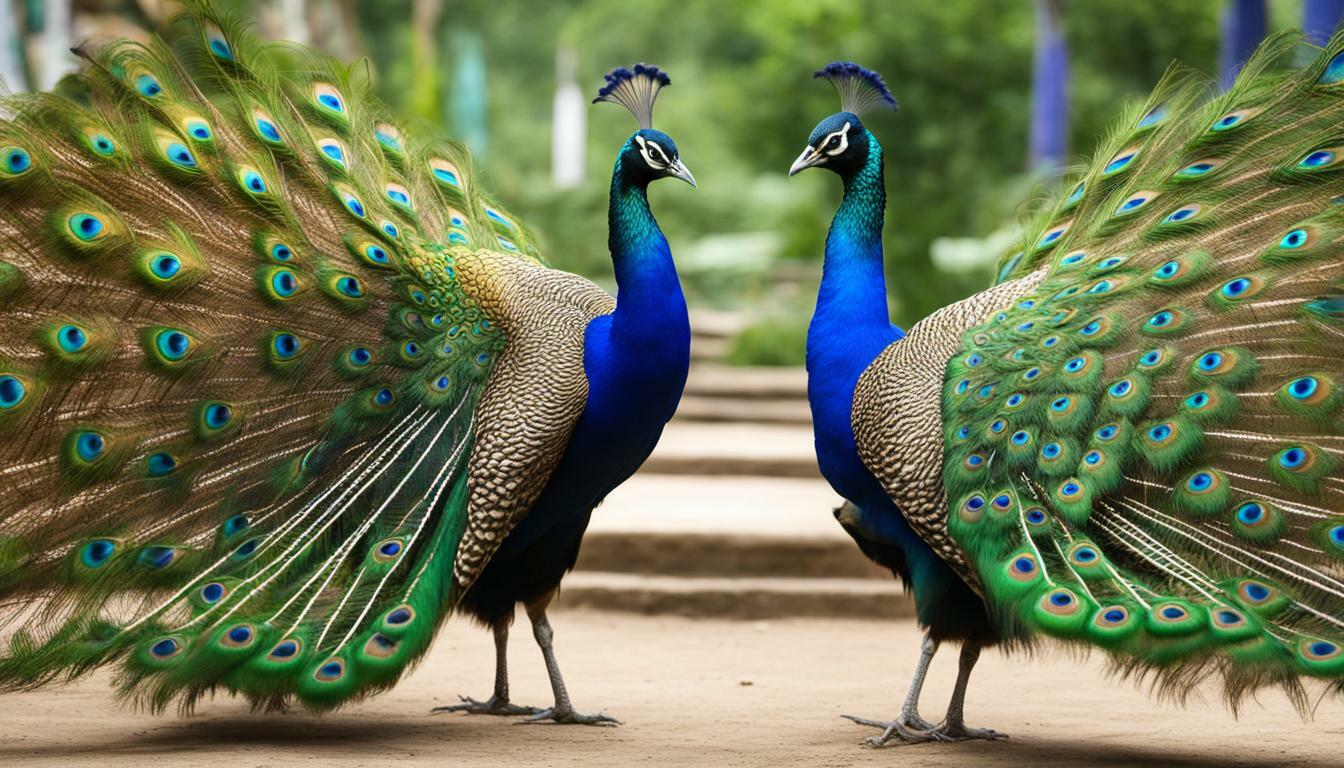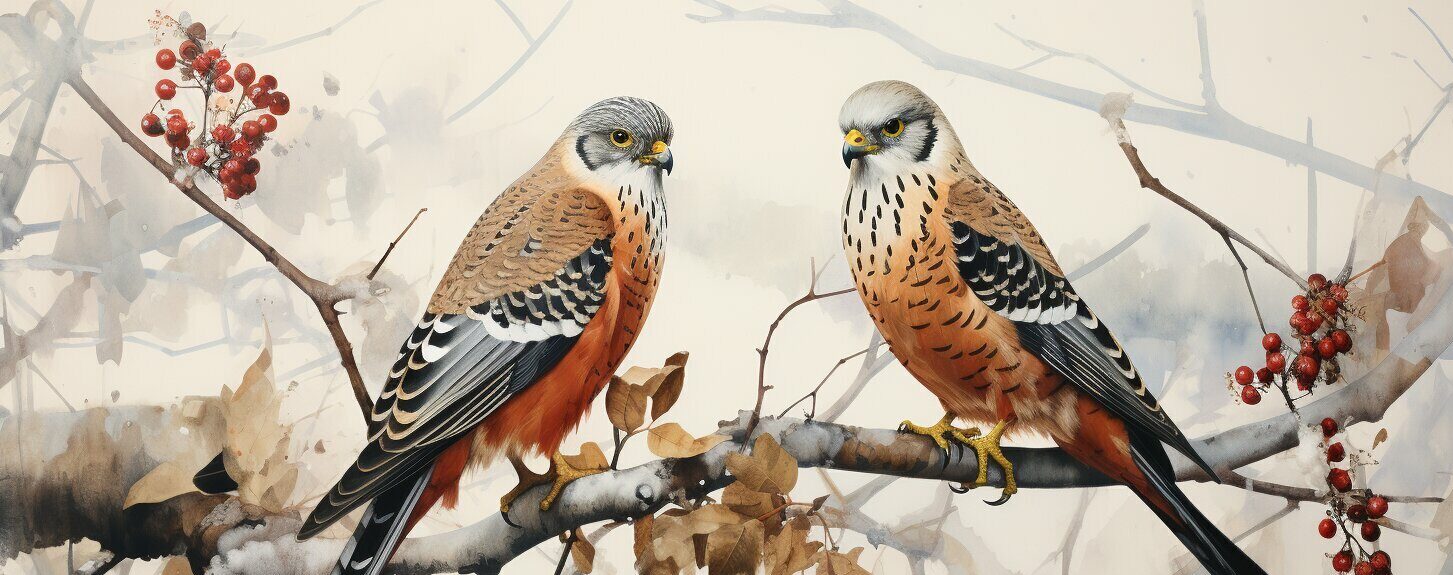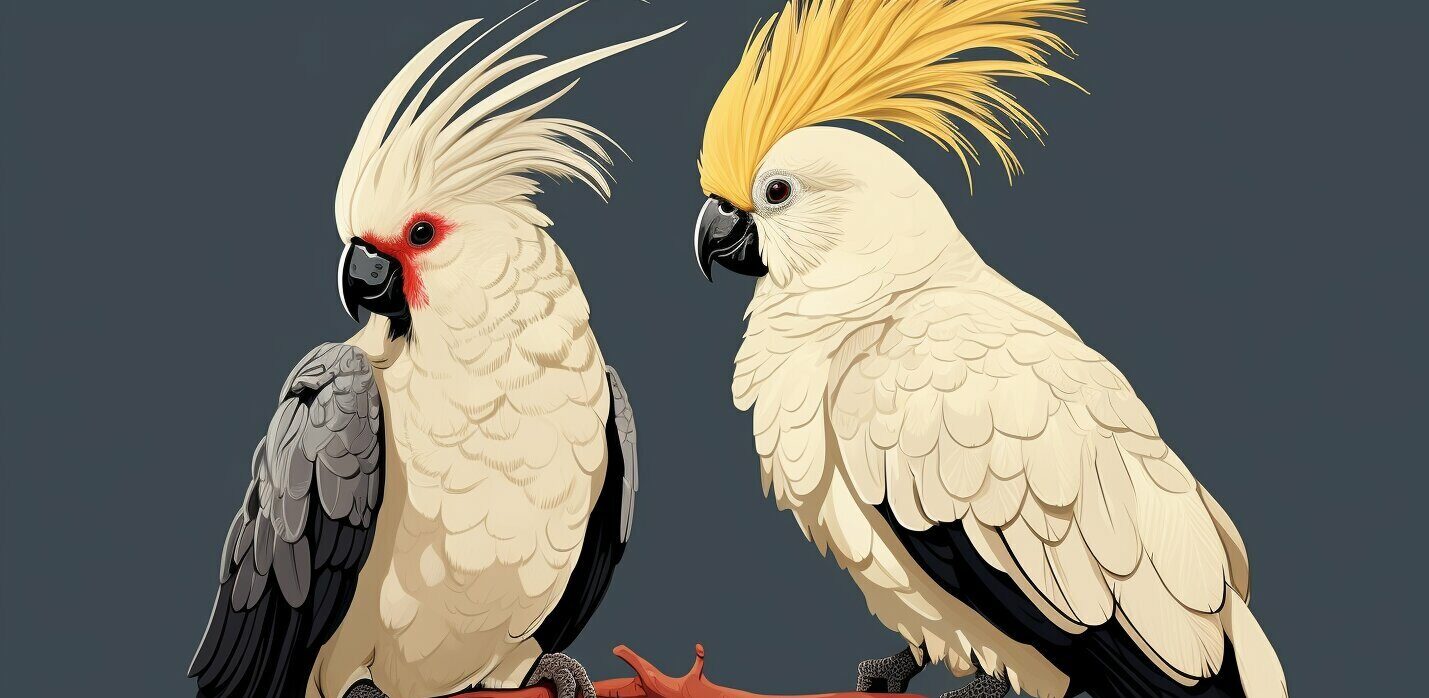Peacocks, with their vibrant and flamboyant feathers, are some of the most mesmerizing creatures in the animal kingdom. Their tails, in particular, are an essential aspect of their beauty, and they play a critical role in mating and reproduction. In this section, we will explore the unique characteristics of tail feathers that differentiate male and female peacocks, and how the male peacock’s elaborate tail has evolved over time.
Key Takeaways:
- Difference Between Male and Female Peacocks: Tail Features
- Male and female peacock differences
- Peacock gender differences
- Peacock tail evolution
Understanding Sexual Dimorphism in Peacock Tails
Peacocks are known for their spectacular tail feathers, but did you know that the extravagance of their plumage varies based on gender? This difference in appearance is known as sexual dimorphism.
In peafowls, sexual dimorphism is especially evident in the tail feathers. Male peacocks have long, ornate tail feathers that they display during courtship rituals to attract mates. In contrast, female peacocks have shorter, less flamboyant tail feathers.
Peacock Gender Identification
So how can you tell the difference between male and female peacocks? One way to identify their gender is by looking at their tail feathers. Male peacocks have larger, more vibrant feathers with distinct eye spots, while female peacocks have smaller, subtler feathers without the eye spots.
In addition to physical characteristics, the behavior of peacocks can also indicate their gender. Male peacocks often display their feathers and perform elaborate dances during courtship, while female peacocks remain more subdued.
By understanding sexual dimorphism in peacock tails and the characteristics that distinguish male and female peacocks, you can better appreciate the beauty and complexity of these remarkable birds.
Male Peacock Tail Features
The male peacock’s tail feathers are undoubtedly one of the most striking features in the animal kingdom, with their vibrant hues and intricate patterns. These long feathers, known as coverts, are covered in tiny, iridescent structures that refract light and create a shimmering effect.
Each male peacock has approximately 150 of these coverts, which are organized in a distinctive fan-like shape that can reach up to six feet in length. The feathers at the center of the fan are shorter and thicker than those at the outer edges, creating a gradual and eye-catching gradient effect.
The feather structure of the male peacock is unique and complex, with various adaptations that enhance their display abilities. The broad, flat shape of the feathers creates a large surface area that can catch the wind and create a rustling sound, further attracting the female’s attention. Additionally, the feathers are relatively lightweight, allowing for easier maneuverability during courtship displays.
Female Peacock Tail Features
While not as extravagant as the male’s, the female peacock’s tail is a beautiful and essential feature. Unlike the male’s iridescent colors and long feathers, the female’s plumage is less ornate and primarily brown in color, with white and black spots.
These differences in plumage are believed to be adaptations that help female peacocks blend in with their surroundings, making them less visible to predators while they incubate their eggs. The female’s tail also serves a vital role in mate selection, with males being attracted to females with brighter and more symmetrical tails, indicating good health and genetic quality.
Interestingly, there is also a phenomenon known as peahen mimicry, where males will purposely display their tails in a way that resembles females to avoid detection by predatory birds. This adaptation underscores the importance of the female’s tail in survival and reproduction for both genders.
In summary, the female peacock’s tail may not be as striking as the males, but it is still a crucial aspect of their survival and mating strategies, showcasing the intricate and fascinating ways in which nature evolves and adapts.
Differences in Tail Features: Male vs. Female Peacocks
Male and female peacocks have distinct differences in their tail features, making it easy to differentiate between the two genders. The male peacock’s tail is longer and more elaborate than the female’s, with vibrant colors and intricate patterns that catch the eye. The female’s tail, on the other hand, is subtler in appearance, with a mix of brown and green feathers.
The size and shape of the tail also differ between the genders. The male peacock’s tail can reach up to five feet in length, while the female’s tail is just over two feet long. The male’s tail feathers are longer and wider, giving the tail a fan-like appearance. The female’s tail feathers, on the other hand, are shorter and more rounded.
These tail features play a significant role in attracting mates. The male peacock’s bright and colorful tail is a display of its genetic fitness, indicating the ability to survive and thrive in its environment. The female, in turn, selects a mate based on the male’s tail and its overall appearance.
Overall, the differences in tail features between male and female peacocks are clear and distinctive, allowing for easy gender identification and enhancing our appreciation for the unique beauty of these birds.
The Evolution of Peacock Tails
Peacock feathers are renowned for their striking beauty, but what is the evolutionary significance behind these elaborate features? The evolutionary journey of peacock tails is a fascinating story that provides insights into the survival and reproductive advantages of these magnificent birds.
Researchers have proposed several theories to explain the development of peacock tails. One theory is that the tail evolved as a means of attracting mates, with the most elaborate tails being favored by female peacocks. Another theory suggests that the tail serves as a form of protection against predators, with its size and complexity providing a visual deterrent to potential threats.
Interestingly, recent studies have also shed light on the role of parasites in the evolution of peacock tails. It turns out that the bright colors and intricate patterns of male peacock tails can attract more parasites than those of female peacock tails. This has led to the development of immune systems that are more robust in males, which in turn has fueled the evolution of even more elaborate tails.
Peacock Tail Evolution Timeline
| Time Period | Event |
|---|---|
| 10-20 million years ago | Peafowl species diverge from other bird families, leading to the development of unique tail structures |
| 5 million years ago | The earliest known ancestor of modern peafowl, Pavo bravardi, appears in the fossil record with a small tail |
| 3-4 million years ago | The first indications of elongated tail feathers appear in the fossil record |
| 1-2 million years ago | The distinctive eye-spots on male peacock tail feathers emerge |
Overall, the evolution of peacock tails is a testament to the power of sexual selection, where traits that enhance reproductive success are favored by females and become increasingly exaggerated over time. Today, male peacock tails are among the most iconic and recognizable features of the animal kingdom, inspiring awe and wonder in all who encounter them.
Identifying the Gender of Peacocks
Peafowl enthusiasts and researchers alike often find themselves in a predicament when attempting to identify the gender of these majestic birds. However, certain physical and behavioral cues can assist in distinguishing between male and female peacocks.
One of the most apparent differences between male and female peacocks is their size. Males are larger and heavier than females, with longer and wider tails. Additionally, their feathers are more vibrant and display intricate patterns, unlike the females’ more subdued plumage.
The shape of the tail is another crucial aspect to consider when identifying a peacock’s gender. Male peacocks have a more fan-like tail, with long, elaborate feathers, while female peacocks have a rounded, short, and less elaborate tail. Males use their tails to attract mates and for courtship displays, whereas females use theirs primarily for camouflage and protection.
Behavioral cues can also aid in peacock gender identification, as males tend to display more dominant behaviors, such as strutting and vocalizing, especially during the breeding season. Females, on the other hand, are more reserved in their behavior and may exhibit maternal tendencies such as nesting and protection of their young.
In summary, physical characteristics such as size, tail shape, and feather patterns, combined with behavioral cues, can assist in identifying the gender of peacocks. A keen eye and attention to detail are essential when distinguishing between males and females of these remarkable birds.
Conclusion
In conclusion, the distinct tail features of male and female peacocks offer a unique glimpse into their evolutionary journey and the significance of these features in mate selection. Through our exploration of sexual dimorphism, we have identified specific visual cues that can help enthusiasts and researchers identify peacock genders accurately.
We have discussed the vibrant colors, intricate patterns, and long feathers that make a male peacock’s tail so captivating, as well as the subtle beauty and adaptations present in the female peacock’s tail. By comparing and contrasting the differences in tail features, we can better understand the unique characteristics of each gender.
Furthermore, the theories behind the development of these elaborate features shed light on the advantages they provide in terms of survival and reproduction, adding to our appreciation of the stunning beauty of peacocks.
In summary, the tail feathers of peacocks are not just a beautiful sight to see. They offer crucial insights into the evolutionary journey of these majestic birds and provide us with a better understanding of their behavior and characteristics.
 Skip to main content
Skip to main content


